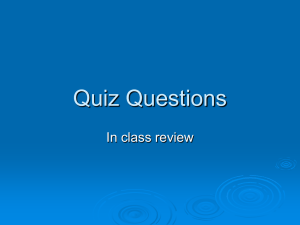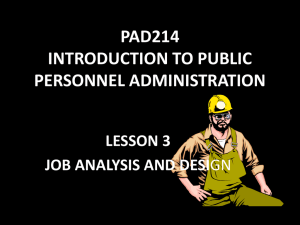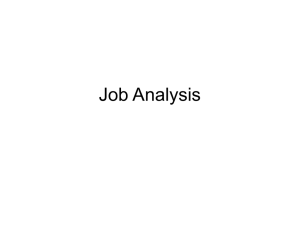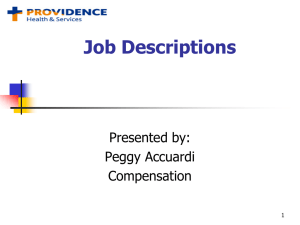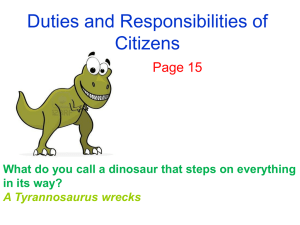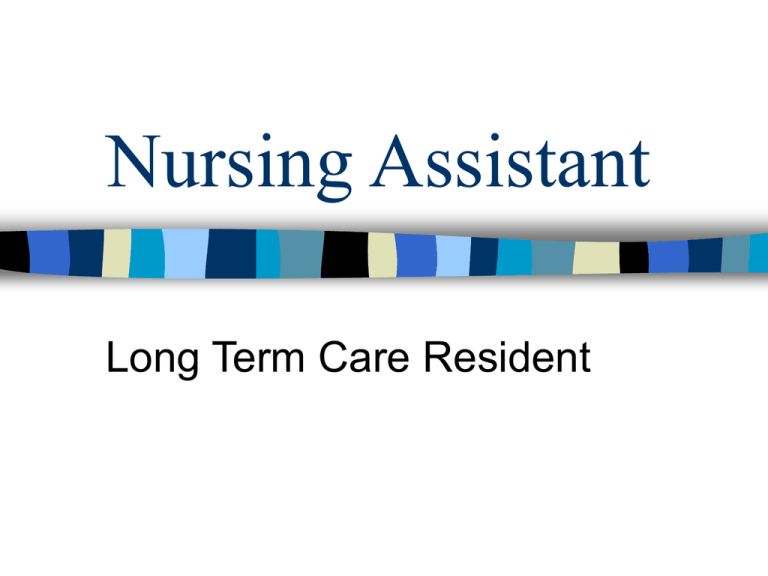
Nursing Assistant
Long Term Care Resident
Basic Human Needs &
Interventions
Environmental/Physical
– Safety
•
•
•
•
More light for better vision
Freedom from hazards
Support & adaptive devices
Good personal hygiene
– Shelter
• Appropriate living situation
• Environmental control (heat/air-conditioning)
– Nourishment
• Balanced diet
• Adequate fluids
Psychological Needs
Maintain self-esteem
– Respectful treatment
– Recognition of individual differences
Adjustment to role change & loss of
independence
– Respect privacy
– Give choices
– Encourage activities
Social needs
Social interactions
– Encourage family involvement
– Encourage social/community activities
Adjustment to losses
– Encourage verbalization/reminiscing
– Encourage new social contacts
– Death of spouse/friends
Financial
– Changes in income
– Refer to social service
Recreational Needs
Diversion
– Encourage hobbies
– Involve in facility/community events
– Encourage family involvement
Self-esteem
– Encourage involvement
– Give compliments
– Reinforce positive traits or abilities
Spiritual Needs
Provide respect for individual choices
Provide opportunities to participate in
religious activities
Community Resources
AAA- Area Agency on Aging
Adult Day Care Center
Support groups
–
–
–
–
–
–
–
American Diabetes Association
Braille Institute or Blind Center
Alzheimer’s Society
Parkinson’s Support
Multiple Sclerosis Support
Muscular Dystrophy
Hospice/Bereavement
County Health Center
More Community Resources
Hospitals & Hospice
IRS information
Long Term Care ombudsman
Meals on Wheels
Medicare & Social Security Office
Mental Health Dept
National Alliance for the Mentally ill
American Disability Act
Adult Protective Services
Red Cross/Blood Pressure Clinic
AND more resources
Senior Centers & housing
Suicide prevention
Home health Agencies
Voter registration
AARP
Fraternal & social organizations
Churches & religious organizations
Organic Brain Syndrome
Also called dementia
– Any disorder of the brain causing deficits in
thinking, memory, or judgment
Causes
– Alzheimer’s disease causes plaques & tangles in
the brain’s nervous system. Brain decreases in
size as cells are lost. Incurable. Progressive
– Multi-infarction dementia
– Parkinson’s disease
– Syphilis
– AIDS
– Nutrition & medication problems
– Depression & metabolic disorders
Schizophrenia
Mental disorder characterized by paranoia,
hallucinations, delusions, bizarre behavior,
distortions of reality
NA duties & responsibilities
– Notify nurse if behavior worsens or endangers
– Do not “feed in” to delusions, but do not try to
convince them of reality
– Be aware of suicide precautions
– Keep resident involved in reality activities
– Report/document responses to meds & therapy
– Monitor nutrition & fluid – often wary of poison
– Find ways to reduce fear & anxiety
Hypochondriasis
Resident imagines or magnifies each
physical ailment
NA duties
– Be supportive, may stem from depression
– Do not overlook real illness
– Report ALL complaints
– Do not judge
Depression
Most common functional disorder in the
elderly
Signs & symptoms
– Feeling sadness
– Lack of interest in & withdrawal from
environment
– Feelings of worthlessness
– Negative outlook on the future
NA duties for depression
Notify nurse for loss of appetite, weight loss,
severe fatigue, crying, sleeplessness
Notify nurse for statements “I wish I could die”
Remain non-judgmental
Listen with empathy
Encourage activities with others
Encourage aerobic activity & outdoor activity
(releases endorphins)
Suicidal Resident
Elderly are at risk, especially white males
over 65 who live alone and the very old (>75)
NA duties
–
–
–
–
–
Report clues of attempts to nurse
Give constant care
Monitor activities
Work to preserve self-esteem
Help resident find support network, friends, clergy,
family, support groups
– Never ignore a statement or threat about suicide
Developmentally Disabled
Significantly sub-average intellectual function
& low adaptive ability
NA duties
–
–
–
–
–
–
Provide a normal environment
Emphasize individual strengths
Encourage independence & self-care
Treat with dignity at age appropriate level
Respect privacy
Provide safe, structured environment
Cerebral palsy
Group of disorders characterized by motor
dysfunctions
NA duties
–
–
–
–
–
–
Provide safe, structured environment
Apply appropriate assistive devices
Emphasize individual strengths
Encourage independence
Treat with dignity
Respect privacy
Alcoholism/Drug Abuse
Occurs when healthy coping mechanisms
have failed
15% of elderly suffer from this
Often triggered by
–
–
–
–
–
–
Retirement
Loss of self-esteem
Loneliness
Chronic pain
Decline in health
Stress
NA duties for alcoholism
Report any sign of resident being under the
influence
Be sure alcohol/drugs are not available
Watch for mental impairment, loss of
coordination, poor judgment
Be careful when feeding, gag reflex may be
impaired
Support groups – AA
Notify nurse if signs of withdrawal
– Alcohol – shaking, tremors, agitation, seizures
– Drugs- runny nose, depression, HA, pacing, poor
coping mechanisms, agitation
Follow care plan
Be aware of dangerous behavior
Agitated Resident
Use of inappropriate verbal, vocal, or motor
activity due to causes other than
disorientation or real need
NA duties
– Report aimless wandering, pacing, cursing,
screaming, spitting, biting, fighting, arguing,
demanding, talking to self
– Maintain quiet, calm environment
– Encourage distracting activities
– Check for constipation or other sources of pain
– Loss of control increases agitation
– Avoid restraints
Agitation continued
Allow resident to walk or rock in chair to
diffuse energy
Make sure you stay safe – maintain area to
escape (way to the door)
Listen with empathy
Call for help if resident becomes violent
Do not attempt to control resident if they
become violent
Redirect
Body’s basic organization
Cell
– Basic unit for structure, building block
– Function, size, shape of cells differ
– Need food, water, oxygen to survive
Tissues
– Groups of cells with similar functions
•
•
•
•
Epithelial – protective
Connective – support & connect
Muscle – shorten & lengthen
Nerve – carry electrical messages
Organs
– Made of different tissues & perform special
functions
Integumentary System
Function
– Protective barrier against microorganisms &
infection
– Provides sensory function – pain, temp
– Shields body from injury
– Temp regulation – heat & cold
– Eliminates waste
– Produces Vitamin D
– Helps maintain fluid balance by preventing fluid
loss & perspiration
– Largest organ of body
Epidermis – top layer
Primarily dry, dead cells that shed
continuously
Thin layer
No blood supply
Barrier to water loss
Prevents infection
Dermis – middle layer
Varies in thickness in different areas of body
Naturally very moist
Gives skin strength
Contains blood vessels, lymph vessels, nerve
ending, oil glands, hair follicles
Function – aid in body temp control & is the
origin of sense of touch, pressure, & pain
Subcutaneous – deepest layer
Fatty tissue, muscle, & bone
Do not tolerate lack of oxygen – cell
death results easily
Skin Lesions/Wounds
Change in skin structure caused by
injury, trauma, aging, or disease
Signs & Symptoms
– Rash
– Raised spots filled with pus or blood
– Irregular reddened areas that itch (Pruritis)
– Dry crusts, scabs
– Break in skin integrity
NA duties for skin lesions
Observe & report abnormalities
Observe drainage on dressings
Tepid water when bathing
Gloves
Do not remove crusts
Notify nurse if skin lesions drain, drainage
changes, dressing needs changing, wound
has redness, red streaks, heat, pus, drainage
Pressure Sores (Decubiti)
Break in skin integrity that develops over a
bony prominence as a result of pressure
Stage One
– Reversible, red area that does not go away after
30 minutes (may look blue or black)
Stage Two
– Reddened skin with abrasions, blisters, or shallow
crater. Can involve dermis & epidermis
Stage Three
– All layers of skin destroyed, deep crater forms
Stage Four
– Ulcer extends through skin & subq tissue. Bone,
muscle, & structures may be involved
NA duties for decubiti
Change position at least q 2 hours
Teach resident to shift position every 10
minutes when sitting
Proper nutrition & hydration
Immediate removal of feces or urine
Inspect skin whenever personal care is given,
esp over bony prominences
Avoid hot water & friction
Lotion is your friend
Separate body areas to avoid rubbing
NA duties cont
Mechanical aids
–
–
–
–
–
Sheepskin
Alternation- pressure mattress
Pillows
Gel & air cushions
Heel protectors
Use draw sheet to move residents
Elevate HOB no more than 30 degrees
Check braces & restraints for fit
Check tubing for rubbing
Report changes to nurse
PREVENTION better than cure
Pediculosis, Lice, Scabies
Tiny parasites living in body
Signs & Symptoms
– Intense itching
• Pediculosis – areas of hair growth
• Scabies – follows blood vessels, seen in webs
of fingers, inside wrists & elbows, underarms,
waist & nipple areas
– Rash
NA duties for parasites
Avoid direct contact, wear gloves
Report any signs of disorder
Thorough washing of linen
Medicated shampoo & lotion
Normal changes of
integumentary system
Skin becomes thin, fragile, dry, wrinkled
Blood supply to fingers & toes
decreases
Less sensitive to hot & cold
Hair loses color
Nails thicken
Bruises easily due to fragile blood
vessels
Respiratory System
Lifeline of the body
Brings oxygen into the body & eliminates
carbon dioxide from body
Organs
–
–
–
–
–
Nose
Trachea
Bronchi
Lungs
alveoli
Respiratory Diseases
URI – upper respiratory infection
– Signs & Symptoms
•
•
•
•
Fever
Runny nose & eyes
Cough
Sore throat
– NA duties
• Encourage rest & fluids
• Dispose of tissues promptly to avoid spread
• Report fever, dyspnea, change in rate or rhythm of resp,
change in mucus color from clear to green, yellow, or
blood-tinged
• Pallor, cyanosis
• Signs that infection is moving to chest or lungs
Pneumonia
Infection/inflammation of lungs, often seen in
residents with poor immune
– Signs & symptoms
•
•
•
•
Same as URI, only more severe
Chest pressure & discomfort
Extreme fatigue/weakness
cough
– NA duties
• As with URI
• Monitor VS carefully, esp temp & resp
• Orthopneic position as needed
COPD
Results in chronic obstruction of the
resp system, irreversible
– Signs & symptoms
• Asthma – breathing disorder caused by
reaction to allergen
–
–
–
–
–
Wheezing
Tight airways
Mucus blocks pathways
Labored breathing
Frequent cough
COPD cont
Chronic bronchitis – prolonged
inflammation in the bronchi due to
infection or irritants
– Persistent cough
– Sputum production, esp in a.m.
– Respiratory distress
COPD cont
Emphysema – occurs when air flow is
obstructed at alveolar level
–
–
–
–
–
–
–
Can bring oxygen in, but can’t expel CO2
Triggered by pollutants, smoke, cold
Freq lung infections
Extreme dyspnea
Loss of appetite/weight loss
Irritability
Air hunger
NA duties with Resp diseases
Teach pursued lip breathing – increases CO2
expiration
Calm resident prn
Orthopneic position
Oxygen therapy
Nutrient dense foods, freq snacks, not meals
Encourage fluids
Pace activities
Avoid raising arms over head
Tuberculosis
Occurs when microorganism enters body &
the inactive tubercle breaks down, bacteria
multiply & spread
– Signs & Symptoms
•
•
•
•
•
•
Fatigue
Night sweats
Hemoptysis
Coughing
Fever
Loss of appetite & weight
Tuberculosis cont
NA duties & observations
– Annual PPD
– Use of barriers if productive cough
– Discard tissues & sputum promptly
Related subjects
Tracheostomy
Esophageal speech & electronic speech
SARS
Malignancies
Aging changes
– Lung capacity decreases due to increased rigidity
in lungs
– Coughing less effective
– Gas exchange in lungs less effective
Cardiovascular System
Transportation system that delivers
nutrition & oxygen to the cells & takes
away waste products
Closed system is kept in motion by the
force of the heart
Anatomy
– Heart
– Blood vessels – arteries, veins, capillaries
Myocardial Infarction
Period in which heart cannot function properly
due to lack of blood supply to the cells of the
heart
– Signs & symptoms
•
•
•
•
•
•
•
•
Crushing chest pain
Diaphoresis
Pallor/cyanosis
SOB
Radiating pain to arm, jaw, back
Loss of consciousness
N&V
Restless, anxious, feeling of impending doom
NA duties with MI
Remain with resident
Notify LVN if signs & symptoms
Monitor VS
Prepare to transfer to acute care facility
CHF
Heart does not pump well enough to meet the
body’s needs
Signs & Symptoms
–
–
–
–
–
–
–
–
Hemoptysis
Cough
Dyspnea & orthopnea
Fatigue, confusion, cyanosis
Edema in extremities
Moist respirations
HTN
Irregular heartbeat
NA role in CHF
Low sodium diet
Position in orthopneic position
Fluid restriction
TED hose
Assist with ADLS
O2 therapy
BSC as needed
I & O, check VS
Pace activities
Anemia
Condition resulting from a decrease in the
quantity or quality of RBCs
– Signs & Symptoms
•
•
•
•
•
•
•
Lethargy
Pale or jaundiced
Dyspnea
Digestive problems
Rapid pulse, increased resp rate
Cold
Dizzy
NA duties with anemia
Provide nutritious meals – increase iron
containing foods – meat, green leafy
veggies
Notify nurse for bleeding or black stool
Monitor VS
HTN – high blood pressure
Signs & symptoms
– Blood pressure >140/90
– Nosebleed
– Red complexion
– HA
– Blurred vision
NA duties & observations
Monitor BP
Assist with stress management
techniques
Low sodium diet
Assist with weight loss efforts
Encourage regular exercise
Notify nurse for signs & symptoms
Related subjects
Pacemakers
Angina
Varicose veins
Atherosclerosis
Internal defib
Aging changes
–
–
–
–
Heart rate slows – less efficient circulation
Vessels lose elasticity
Longer recovery to normal pulse after exercise
Heart is less effective pump
Musculoskeletal System
Forms framework that supports body &
allows for movement
Anatomy
– Bones
– Joints
– muscle
Arthritis
Inflammation of joints
Rheumatoid
– Joint tissue lining affected
Osteoarthritis
– Cartilage covering ends of bones deteriorates &
ends of bones rub together
Gout
– Metabolic disease caused by deposits of crystal at
joint
Arthritis
Signs & symptoms
– Pain & deformity at joint
– Swelling & tenderness
– Heat at inflamed site
NA duties
–
–
–
–
–
Notify nurse if discomfort
Balance rest & exercise
ROM when no pain/inflammation
Rest joint if pain/inflammation
Prevent contractures
Fractures
Signs & symptoms
–
–
–
–
Pain, swelling, bruising at site
Exposed bone through skin – compound
Immobility of area affected
deformity
NA duties
–
–
–
–
–
Keep area immobilized – case, splint
Report pain
Decrease edema – elevate area
Maintain alignment
Cast care – no breaks, chips. Check distal pulses,
CMS distal to cast
– Report signs of infection
Osteoporosis
Caused by bone loss and results in porous,
spongy bones that fx easily. Most common in
elderly females
Signs & Sx
– Fracture from very little or no trauma – often in hip
or low back
– Curvature of spine
– Loss of height
– Progressive weakness
NA duties for osteoporosis
Prevent further fractures
Report pain
Gentle ROM
Apply splints or braces as ordered
High calcium meals – milk, dairy, green leafy
veggies
Mechanical lift for transfers
Gentle handling & positioning
Hip fracture
Fx of femur – commonly caused by falls
or osteoporosis
Signs & sx
– Can’t get up after fall
– Elevated side is shortened & externally
rotated
– Severe pain in hip or knee
– Edema in hip, thigh, groin
NA duties for hip fx
Pre-op
– Avoid moving pt unless instructed by nurse
– Use sheet or back board to move
Post-op
–
–
–
–
–
–
–
Do not flex hip > 90 degrees
Do not cross affected leg over midline of body
Do not internally rotate hip on affected side
Do not do passive ROM on affected side
No weight bearing for several weeks
Use fracture bedpan
Maintain proper hip alignment – trochanter rolls,
abduction pillows
Related subjects
Fibromyalgia, traction, CPM machine, back
injuries, amputation, Lyme disease
Aging changes of M/s system
– Loss of elasticity in muscles
– Bones lose minerals, become brittle & easily
broken
– Less flexible
– Posture becomes slumped
– Degenerative changes in joints
– Loss of height
– Decreased reflexes, prone to injury & falls
Endocrine System
Network of glands secreting hormones
directly into bloodstream
Organs & glands
– Pituitary – master gland
– Thyroid – controls metabolism
– Pancreas- secretes insulin to promote glucose use
by cells
– Adrenals – secretes adrenalin (flight or fight)
Diabetes Mellitus
Chronic disease resulting from insulin
deficiency or insulin resistance. Body is
unable to properly process food &
convert food into energy
Type 1 – insulin dependent
Type 2 – non-insulin dependent
Signs & Symptoms of diabetes
Polyuria – excessive urination
Polydipsia – excessive thirst
Polyphagia – excessive hunger
Fatigue
Skin infections that are slow to heal
Itching
Burning on urination
Vision changes
More signs & symptoms
Hyperglycemia
– Develops slowly over 24 hours
– Confusion, drowsiness, slow slippage into coma
Headache
Sweet fruity odor to breath
Deep breathing
Low blood pressure
N&V
Flushed, dry, hot skin
Unconsciousness
Sugar in urine & high sugar in blood
Hypoglycemia
Occurs when blood glucose in below normal
Most common from insulin OD
Symptoms – occur rapidly
–
–
–
–
–
–
–
Hunger, weakness, dizziness, shakiness
Moist & clammy
Rapid, shallow respirations
Nervous & excited
Rapid pulse
Unconscious
No sugar in urine & low sugar in blood
NA duties with
hypo/hyperglycemia
Know signs & symptoms & notify nurse if
present
Offer meals & snacks at regular intervals &
report uneaten portions
Illness, stress, & infection cause unregulated
blood sugar
Check extremities for infection, trauma,
wounds
Notify nurse if vomiting after meals
Offer easily digested CHO if signs of
hypoglycemia after notifying nurse
More NA duties
Make sure right diet is given
Urine testing for sugar & acetone
Foot care
–
–
–
–
Wash feet daily, dry between toes
Inspect feet for signs of irritation
Toenails to be cut by nurse or podiatrist ONLY
Shoes & stockings worn at all times when out of
bed (no barefoot)
– Check for anything impairing circulation
– Diet, exercise, medication are most important
components of diabetic treatment
Related subejcts
Hypo & hyperthyroidistm
Cushing & Addison’s disease
Glucose monitoring
Aging changes in endocrine system
– Decrease in sex hormones
– Body less able to handle sugar
– Metabolism & body functions slow
Nervous System
Controls, directs, & coordinates functions of
body
2 division – CNS, PNS
Anatomy
–
–
–
–
Brain
Spinal cord
Peripheral Nerves
Sensory organs – eye, nose, tongue, skin, ears
Dementia
Any disorder of brain causing deficit in
thinking, memory, & judgment
Signs & Symptoms
– Mild dementia – Stage One
•
•
•
•
•
•
•
•
Short term memory loss
Personality changes
Disorientation to time
Poor judgment
Lack of safety awareness
Careless in appearance
Anxious, depressed
Delusions of persecution
Stage 2 – moderate dementia
Increased short term memory loss
Complete disorientation
Wandering & pacing
Sundowning
Preservation phenomena
Motor skills deteriorate
Speech, reading, writing deteriorates
Incontinent of bowel & bladder
Catastrophic episode
Stage three – severe dementia
Totally dependent
Verbally unresponsive
May have seizures
NA duties for dementia
Protect resident from injury
Be compassionate, calm, patient, maintain
sense of humor
Encourage independence as long as possible
Provide mental & physical activities within
resident’s capabilities
Provide structured quiet environment that is
uncluttered
Use appropriate body language – resident
“reads” staff behavior & reflects mood
More NA duties
Give one short, simple direction at a time
Observe for signs of physical illness –
resident may be unaware
Assist with grooming & dressing
Monitor food & fluid intake
– Do not use plastic utensils
– Provide nutritious finger foods when resident
unable to use utensils
– Be aware of swallowing difficulties
– Prepare food & encourage resident to self feed as
long as possible
– Check food temps
– Check resident’s mouth for “squirreling”
– Weigh residents to detect gain or loss
More NA duties
Use touch appropriately – surprising resident
can result in catastrophe
Avoid using logic, reasoning, or lengthy
explanations
When ability to speak is lost, watch nonverbal
– Biting, scratching, kicking show displeasure
– Facial expressions & body language show mood
– Observe for triggers of agitation or anger & avoid
Use distration & diversion when resident is
agitated, take hand & calmly walk to another
activity
More NA duties
Realize people with dementia are not
responsible for what they say
– They cannot change
– They are not aware of what they are doing
– They have poor impulse control
– Allow them to “save face” by preserving
their dignity
– No one really knows what is happening in
the minds of people with dementia
More NA duties
Be aware of wandering & pacing
– Record patterns
– Triggers can include
•
•
•
•
•
•
•
•
•
Noise – keep quiet avoid crowds
Boredom – give activities
Unmet physical needs – evaluate
Stress- create calm environment
Pain – evaluate for discomfort
Hunger – offer freq snacks
Thirst – encourage fluids
Need to toilet- take to restroom every 2 hours
Looking for companionship, security, or loved one –
therapeutic touch, talk, consistency
• Physical restraints – feel threatened
• Looking for a state of mind, not location
More NA duties
If they are in area they shouldn’t be, calmly
take by hand & redirect
Avoid large numbers of staff approaching
resident
Use positive directions “stay inside” instead of
“don’t go outside”
Use gentle persuasion
Compliment positive behaviors &
accomplishments
Encourage rocking chairs to diffuse energy
More NA duties
Be aware of sundowning & prevent
– Avoid over-fatigue
– Encourage resident to stay awake in day
– Evening meal should be at least 2 hours before
bedtime
– Eliminate caffeine
– Evening activities should be calm & quiet
– Soft music is calming
– Give massage/back rub
– Light bedtime snack
– Follow bedtime routine
– Check lighting – shadows & reflections can be
scary
More NA duties
Discourage pillaging & hoarding
– Label all resident’s belongings
– Check room daily for stale food
– Keep resident’s hands busy
– Provide a “rummaging” drawer or box for
resident
More NA duties
Use reality orientation to regain connection to
environment
–
–
–
–
–
–
–
–
–
Especially affective in Stage One
Use clock & calendar at bedside
Call by name
Answer questions honestly, but do not give
information they are unable to handle (asks about
deceased husband)
Do not argue with resident’s reality
Use bulleting boards decorated for season
Keep curtains open during day
Make sure they wear glasses/hearing aids
Do not expect resident to remember you
More NA duties
Use reminiscing therapy
– Encourage sharing memories of past
– Use prompting questions to show interest in their
history
– Use active listening skills
– Reminiscing serves as life review & may validate
self-worth
– Acknowledge validity of feelings & emotions
– Reminiscing helps people adapt by working
through personal loss
More NA duties
Incorporate validation therapy
– A way for residents to work through issues that
were unresolved
– Have pictures or reminders of past in room
– Realize there is a reason for all behavior
– Living must be resolve in order to prepare for
dying
– To live in reality is not the only way to live
– Disoriented people have worth – still experience
joy, pleasure, & ability to appreciate kindness
– Remember every person was a child, teenager,
adult, just like you
Incorporate music & animal therapy
CVA
Complete or partial loss of blood supply to
cells of brain
Signs & Symptoms
–
–
–
–
–
–
–
Loss of sensation
Paralysis/hemiplegia
Aphasia
Dysphagia
Emotional liability
Loss of consciousness/confusion
Cognitive impairments
NA duties for CVA
Report changes in level of motor activity,
consciousness, or HA
Prevent complications of immobility
Begin restorative care – assist with ADLs,
encourage self care
Be supportive emotionally – PATIENCE
Explore alternative methods of
communication if unable to speak
Be aware of swallowing/choking when
feeding
Incorporate reality orientaiton
TIA – Transient Ischemic Attack
Mini stroke –
– caused by lack of oxygen to brain cells
– Signs & symptoms are temporary
– Signs subside when circulation is improved
Parkinson’s Disease
Signs & Symptoms
– Tremors & pillrolling
– Muscle rigidity
– Difficulty & slowness in carrying out voluntary
motor activities
– Shuffling walking
– Slurred speech
– Loss of expressiveness in face
– Drooling
– Incontinence
– Constipation & urinary retention
– Mood swings & depression
NA duties for Parkinson’s
Maintain calm environment – symptoms
worsen with stress
Assist in ADLs
Provide emotional support
Exercises for restorative care
Dementia care
Seizure disorder
Recurrent, transient attacks of disturbed brain
function
– Signs & symptoms Generalized seizure
•
•
•
•
•
•
“aura” or taste before seizure activity
Jerking & twitching of body
Entire body involved
Person may lose consciousness
Incontinence
May be followed by period of fatigue, confusion,
disorientation
Signs & Symptoms – Partial
seizure
Momentary loss of muscle tone
May have periods of unconsciousness
May chew, blink, or breathe rapidly
Lasts 2 – 10 seconds
“absence seizures” in children
Only one extremity or part of extremity
may be involved
Signs & Symptoms – status
epilepticus
Lasts long period
Serious medical emergency
Life threatening
Death may result
NA duties during seizure
During seizure
–
–
–
–
–
Stay with person, call for help
Assist to lay down
do not restrain or put anything in mouth
Move away objects that may hurt person
Maintain airway by loosening clothing, turn head
so saliva/emesis drains out, lift shoulder & allow
head to tilt back
– Watch & observe so you can report type of seizure
NA duties after seizure
Allow to sleep
Clean if incontinence has occurred
Check VS
Vision impairments
Cataracts – normally clear lens
becomes cloudy
– Signs & Symptoms
• Cloudy lens over eye
• Leading cause of vision loss in adults over age
55
– Follow post-op protocol if surgery has been
performed
Glaucoma
Increased pressure within eye
Signs & symptoms
–
–
–
–
–
–
–
Eye pain
Difficulty adjusting to darkness
Unable to see color
May see “halos”
HA
Fatigue
Blurred vision
NA duties with vision
impairments
Announce yourself by name when entering
room
Encourage tv or radio listening
Be extra careful in explaining what you are
doing
Describe food placement like hands of clock
Do not disrupt environment, keep ADL
supplies in same place
Do not move furniture unless necessary
Encourage independence
Hearing impairments
Otosclerosis – progressive form of deafness,
unknown cause
Related subjects – West Nile Virus,
autonomic dysreflexia, Mad Cow Disease
Nervous system complications of immobility
– Weakness, limited mobility
– Insomnia from sleeping during day
Nervous System Aging changes
Slowing nerve transmission results in delayed
reaction time, poor coordination, & balance
Less effective temp regulation
Decreased sensitivity to pressure & temp
changes
Decreased blood flow to brain results in
memory loss & confusion
Deep sleep is shortened, need naps
Gastrointestinal System
Responsible for breaking food into simpler
substances that can then be used by body
cells for nutrition
Organs
–
–
–
–
–
–
–
Mouth, teeth, tongue
Esophagus
Stomach
Small intestine
Large intestine
Liver & gall bladder
pancrease
Malignancies of GI system
Cancerous growths in GI tract that can cause
obstruction & may result in surgery &/or
ostomy
Signs & symptoms
–
–
–
–
–
–
–
Vomiting
Extreme abd discomfort
Indigestion
Constipation
Blood in stool
Flatus
No bowel movement at all
NA duties for malignancy
Monitor BM & report discomfort
Care of ostomy – artificial opening in abd wall
for elimination of solid waste & flatus
–
–
–
–
–
–
–
–
–
–
Standard precautions
Remove appliance gently to prevent skin irritation
Empty bag & wash if reusable with soap & water
Secure clamp at base
Discard disposable bag in biohazardous waste
bag & replace
Observe stoma for redness, irritation, & skin
breakdown
Wipe area around stoma gently, wash with soap &
water
Apply creams, fit opening of appliance to stoma
Seal well to prevent leakage
Observe color, character, amt, freq of stools
Constipation
Abd or rectal pain
Inability to pass stool
Loss of appetite
Feel urge to defecate but unable to
Bloating/abd distension
Liquid stool or mucus seeping from rectum
Hard, dry stool
Caused by decreased fluids, diet, inactivity,
meds, or ignoring urge to defecate
Fecal impaction
Stool unable to pass from rectum
Results from unrelieved constipation
Diarrhea
Liquid or unformed stool with increased
frequency
Feces moves rapidly through the
intestines
Caused by infection, meds, irritating
foods
Anal incontinence
Inability to control passage of feces &
gas
possible cause due to injury or
diseases of nervous system or sphincer
damage
May result when residents do not
receive the assistance they need in a
timely manner
Flatulence
Excessive formation of gas in stomach
& intestines
Caused by foods, meds, or air
swallowing
NA duties with GI difficulties
Monitor & record BM, notify nurse with
problems
Encourage high fiber diet if constipation
FF
Encourage exercise to stimulate BM
Prompt attention to call light
Monitor skin integrity
Prompt attention to incontinence care
NEVER perform digital removal of an
impaction
Related subjects
Gall bladder disease
Hernias
Ulcerations
Bowel training
Enemas
Rectal tube
Hemorrhoids
GI system aging changes
Decreased saliva production causing
dysphagia
Taste buds not as sensitive
Decreased gag reflex leads to change of
choking
Slowed peristalsis leads to indigestion &
constipation
Decreased ability to absorb nutrients
Meds related to side effects
Sensitivity to sensation of full bowel
Urgency is exaggerated with bowel
Urinary System
Filters flood & produces urine in which
excess fluids & toxins are excreted
1000 – 1500 cc of urine /day
Characteristics of normal urine
– Clear
– Amber
– Mild odor
Anatomy of urinary system
Kidneys – filter blood, produce urine
Ureter – tube from kidneys to bladder
Bladder – storage for urine
Urethra – tube from bladder to outside
Cystitis
Signs & Symptoms
–
–
–
–
–
–
–
–
Dysuria, burning
Frequent urination
Cloudy urine
Hematuria
Bladder spasm
Loss of appetite
Fever
Confused resident may become agitated
NA duties for cystitis
Encourage fluids
Observe urine
Siz bath
Perineal care
Always wipe front to back
Rest
Urinary incontinence
Signs
– Unable to control urination
– Stress incontinence
NA duties
–
–
–
–
–
–
Bladder training
Toilet regularly
Answer call light promptly
Be positive when changing, not critical
Perineal care
Avoid liquids after dinner
Urinary System Aging Changes
Kidneys decrease in size & are less efficient
Bladder loses tone, leading to retention &
infection
Decreased bladder capacity leads to nocturia
Kidney function increases at rest, causing
urination at night
Prostate enlargement in men causes
frequency, dribbling, & urinary retention
Elderly may exhibit behavior changes with
usual UTI signs
Decreased sensitivity to sensation of full
bladder
Urgency exaggerated with bladder
Reproductive system
Produces hormones & responsible for
reproduction
Anatomy
– Male – penis, testes, prostate
– Female – ovaries, fallopian tubes, uterus,
vagina, vulva
Common diseases of
reproductive system
Male
– Enlarged prostate gland – urethra passes through
prostate, as it enlarges, it strangles urethra,
causing difficulty in starting stream & emptying
bladder
– CA of prostate or testes
Female
– Cystocele – weakening of muscles between
bladder & vagina
• Urinary incontinence
• Frequent UTI
Female disorders
Rectocele – weakened muscles between
rectum & vagina
– Hemorrhoids
– Constipation
Prolapsed uterus
Malignancies – breast, ovarian, uterine,
cervical
NA duties
– Supportive care
– Notify nurse if distress
STD
HIV – viral infection
– Signs & symptoms
•
•
•
•
•
•
•
•
•
•
Flu-like
Fever
Night sweats
Fatigue
Swollen lymph nodes
Sore throat
GI upset
HA
Kaposki’s sarcoma
Pneumocystis carinii pneumonia
NA duties for HIV
Be aware virus if killed by 10:1 water to
bleach solution, solution good for 3 days
Prevent secondary infections
Report new symptoms & discomfort to
nurse
Provide comfort measures
Aging changes
Male
– Scrotum less firm
– Increase in size of prostate gland
– Hormone production decreases
Female
–
–
–
–
Fewer hormones produced
Ovulation & menstrual cycle cease
Vagina becomes thinner, drier
Breast tissue decreases & muscles supporting
breasts weaken
Immune System
Protects body against disease
Special cells
– WBC
– Antibodies
– Antigens
– T cells – destroy invading cells
When body sense an antigen, immune
system is activated
AIDS
Caused by HIV
Spread through body fluids
– Blood
– Semen
– Vaginal secretions
– Breast milk
Affects body’s ability to fight other
viruses and bacteria
S & S of AIDS
Loss of appetite
Weight loss
Fever & night sweats
Diarrhea
Painful or difficult swallowing
Extreme & constant fatigue
Skin rashes
Swollen lymph nodes
Cough
Sores or white patches in mouth or on tongue
Purple blotches or bumps on skin
Confusion & forgetfulness
dementia
NA duties with AIDS
Standard precautions & blood borne
pathogen standard
Daily hygiene – avoid harsh soaps
Oral hygiene before meals & at bedtime,
toothbrush with soft bristles
I & O, encourage fluids
Daily weight
Encourage deep breathing
Prevent pressure sores
Assist with ROM & ambulation
Encourage self care, may need assistive
devices
NA duties with AIDS
Change linen, gown as often as needed
when fever present
Be good listener & provide support
Considerations
– AIDS often missed because aging masks
S&S of AIDS
– May take 10 – 15 years to develop AIDS

